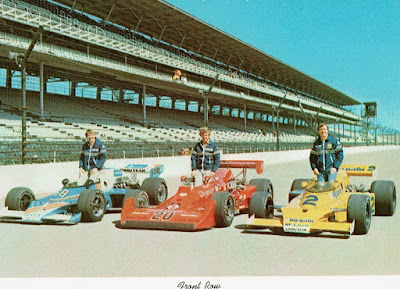 |
Majeske Collection Press kit photo for Crockey Peterson's entry for the 1973 Indianapolis 500. |
Back when I started following the Indianapolis 500 with
fervent interest, I pored over the program to try to memorize the car and
driver combinations for that year’s race. Basically, I wanted to be THE source
for my family when we went to the track and they would ask, “Who’s that?” as a
car sped by.
One car and driver we never saw at the Speedway in 1973 – in
fact, no one saw – was Crockey Peterson. In addition to being listed in the
official program with his Dr. Pepper Special, Peterson also was assigned garage
space. He had garage 34 for his No. 38 entry and garage 35 for his No. 96 mount.
His neighbors in Gasoline Alley were to be Lee Brayton (No. 61 Eisenhour
Special) in garage 33 and Dee Jones (No. 51 Minnesota Serendipity) in garage
36. Incidentally, Brayton and Jones never qualified for the 500, though Lee’s
son, Scott, was a two-time pole-winner.
Peterson never made it on to the track because USAC refused
to let him take a rookie test. I assume his entry fee of $1,000 per car was
refunded. Also denied that year were Eldon Rasmussen and Billy Shuman, who were
to be teammates for the Quality Racing Team. Rasmussen came back in 1974, then
qualified for the 500 in 1975, ’77 and ’79. As far as I can tell, Shuman, like
Peterson, never returned to Indianapolis.
As a warm-up to Indianapolis, Peterson competed in twin
races at Trenton International Speedway. Unfortunately, he was plagued by
mechanical trouble in both races. In the first contest, he managed only two
laps before going out with a fuel leak, finishing 23rd out of 24
starters. The second race wasn’t much better as a water leak sidelined him
after 43 laps. Peterson wound up 18th out of 21 starters.
“I did everything they told me to do, but they turned me
down anyway,” Peterson was quoted as saying in a story by Jerry Miller in the
1973 Indianapolis 500 Yearbook.
So who was Crockey Peterson? According to his bio in IMS’
press book for 1973, his full name was Howard Glenn Peterson, his hometown was
Desloge, Missouri, and that, among other pursuits, he was a Pepsi Cola and Dr.
Pepper bottler. The news release from his press kit states that Crockey Peterson
Racing Enterprises was based out of Flat River, Missouri, and that he was the
first rookie and the second driver overall to file an entry for the 1973
Indianapolis 500. (Desloge and Flat River are both about 60 miles south of St.
Louis.)
That news release contained all sorts of interesting tidbits,
including Peterson co-driving with A.J. Foyt in sports car races in Nassau,
Bahamas, in 1963. The release also said Peterson was “good friends” with hall
of fame mechanic Ray Nichels.
I checked that out with my good friend William R. LaDow, who
has written many articles about Nichels and basically has been entrusted with
the family archives. Bill said that Nichels may have loaned Peterson a Monte
Carlo for a USAC stock car race in July of 1972 at Indianapolis Raceway Park.
The chassis was listed as a 1972 Brabham copy, half “monique”
(maybe the writer meant “monocoque”?) and half tubular powered by an 850-hp
Offy capable of a top speed of 220 mph. (Hmmm.)
Peterson’s last IndyCar appearance was at Milwaukee on June
10, 1973. He placed 20th out of 24 starters, going out after 13 laps
with an overheating issue. He competed in two other USAC events in 1970, both
on road courses, with sponsorship from Pepsi. Unfortunately, the results were
similar because of mechanical woes. He was 19th in the William
Murray 150 at Sears Point on April 4, 1970. He completed four laps before going
out with an oil leak. Peterson was 20th in the Rocky Mountain 150 as
clutch failure knocked him out after just two laps.
Looking back 50 years, it’s too bad Peterson didn’t at least
get a chance to start his rookie test. Dr. Pepper did make its way into racing,
including sponsoring Marco Andretti at select races.
 |
Majeske Collection Crockey Peterson's entry in the 1973 Indianapolis 500 program. |
Sources:
1973 Indianapolis 500 program; 1973 Indianapolis 500 trackside report; 1973 Indianapolis 500
Yearbook published by Carl Hungness; The Indy 500: An American Institution
Under Fire by Ron Dorson; 57th Annual Indianapolis 500-Mile Race
Press/TV/Radio Fact Book; Press kit from the Dr. Pepper Company and Crockey
Peterson Racing Enterprises




































